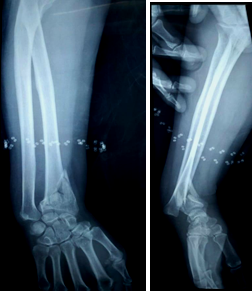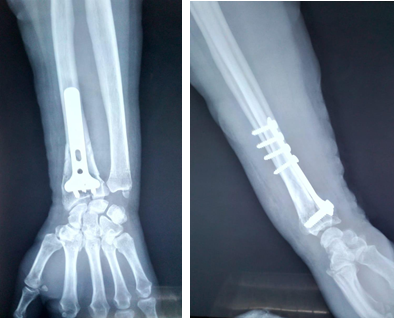
D. Oudrhiri 1*, H. Filali Baba 2, O. Moctar 3, M. Elkhannouche 4, M. Miloudi 5, H. Abid 6, M. Elidrissi 7, A. Elibrahimi 8, A. Elmrini 9
Department of orthopedic surgery, chu hassan ii fez, morocco
*Corresponding Author : D. Oudrhiri, Department of orthopedic surgery, chu hassan ii fez, morocco.
Received Date: February 08, 2021
Accepted Date: February 12, 2021
Published Date: February 18, 2021
Citation: D. Oudrhiri, H. Filali Baba, O. Moctar, M. Elkhannouche, M. Miloudi. “ The Interest of the Locked Plates in the Treatment of The Fractures of Distal Radius Fractures (About 30 Cases).’’. J Orthopaedic Research and Surgery, 2(1) ; DOI: http;//doi.org/03.2021/1.1005.
Copyright: © 2021 D. Oudrhiri. This is an open access article distributed under the Creative Commons Attribution License, which permits unrestricted use, distribution, and reproduction in any medium, provided the original work is properly cited.
,
Introduction :
The fractures of the distal radius are classically the prerogative of the osteoporotic old woman but they often occur at the active young subject following a traumatism with high energy.
The purpose of the treatment is to restore bone et articular anatomy of distal radius by a reduction, and to maintain this reduction by a means of stabilization making it possible to avoid secondary displacements.
The emergence of the locked plates has shown encouraging results. The aim of this work is to highlight the advantages of the locked plate in distal radius fractures.
Materials and methods :
This is a retrospective study of 30 cases of distal radius fractures treated surgically with a locked plate at the B4 orthopedic traumatology department of CHU HASSAN II in Fez during the period from January 2017 to June 2019.
We excluded from this study the extra-articular fractures of distal radius with posterior displacement (colles fractures)
Results :
The average age is 44 years with extremes ranging from 20 to 88 years and a slight predominance of women (56%) with a sex ratio of 1.13. The causes were dominated by falls in 18 cases (60%), followed by road traffic accidents in 6 cases (20%). The right side was affected in 16 cases (53%) with involvement of the dominant side in 13 cases (43%). Bilateral involvement was found in 2 cases, or 6.6%.
Clinically, pain and complete functional impotence of the upper limb were found in all patients, with an attitude of traumatized upper limb. 2 cases of open fractures grade 1 from Couchoix and Duparc classification were founded with section of the radial artery in one of the cases. Associated bone lesions founded : radial styloid fracture in 3 cases (10%), ulnar styloid fracture in 2 cases (6.6%), 2 cases of distal radioulnar joint dislocation (6.6%). A standard AP and lateral radiograph was performed in all patients with additional CT in 2 patients.
According to the Castaing classification: 12 cases of Goyrand Smith fractures (40%), 6 cases of sagittal T fractures (20%), 4 cases of frontal T fractures (13.33%), 4 cases of Simple anterior marginalis fractures (13.33%) and 4 cases of complex anterior marginalis fractures (13.33%).
Therapeutically, the average operating time was 1.5 days with extremes (1 day and 3 days), the average duration of the operation was 31 minutes (25-50 minutes). Plexus block was performed in 20 patients (66%), general anesthesia was performed in 10 patients (34%) given the associated lesions for which they must be operated. we performed a locked plate osteosynthesis for all our patients by anterior Henry's anterior. An associated styloid pinning was performed in 2 patients given the external comminution. All patients were immobilized with a cuff splint for 3 weeks with prescribed rehabilitation at the third week.
The average follow-up was 9 months with extremes ranging from 6 to 30 months. Objective assessment was performed by the Quick Dash score which averaged 24 (11-70) with a higher score in sagittal T and frontal T-joint fractures. On control radiographs, the sagittal inclination of the radial glenoid varied between 5 ° and 10 °, the radioulnar index was normalized in 27 cases and zero in 3 cases, the frontal inclination of the radial glenoid varied between 15 and 25 °. All the fractures healed with an average time to union of 46 days (45-60 days). For outcomes, we noted a material infection in one patient (open fracture initially with bad adherence to therapy), secondary displacement in one patient, algodystrophy of the wrist in one patient, vicious callus in one patient and stiffness in the wrist in 5cases.
Discussion :
The average age of our series is 44 years with a female predominance of 56%, which joins the Facca series[1] (65% of women) and which can be explained by osteoporosis, which is more marked after menopause. The mechanism was dominated in our series by the falls on the hand which joins the series of Dario Perugia [2] and that of Facca [1]. These series reported a predominance of the non-dominant side in most cases, which is consistent with our series.
The treatment of distal radius fractures remains controversial, the multiplicity of techniques employed accounts for the difficulties encountered and suggests that none represent unequivocal and perfect treatment. In our series, the locked plate by the anterior approach was used for all cases and in all cases, the fracture site was approached by an anterior approach and this site was directly restrained by a locked "T" plate (Figure 1 et 6).

Figure 1 : Comminuted Fracture Of Distal Radius With Distal Radioulnar Dislocation

Figure 2 : surgical treatment with locked plate, the distal radioulnar joint had been reduced.
We noted as outcomes a case of secondary displacement (3.33%) which joins the series of EL HASSANI [3] (6%) and that of Dario Perujia (8%) [2]. One patient presented with algodystrophy of the wrist (3.33%) with one case of articular vicious callus (3.33%) which is consistent with other series in the literature [3,4,5,6]. In terms of wrist mobility, 5 cases had stiffness of the wrist (1 case with a vicious callus, one case of algodystrophy and 3 cases of lack of rehabilitation). The results of our series were qualified as excellent and good in 80% of cases with an average Quick Dash score of 24, which matches the series in the literature (26.1 for the series by EL HASSANI [3], 25.3 For S .Facca [2]). Radiologically, in our series, the distal radioulnar index is restored in 90% of cases with normal sagittal and frontal inclinations of the glenoid.
|
|
Secondary displacement |
Vicious callus |
stiffness of the wrist |
|
Dario perugia [2] |
8% |
0 |
0 |
|
S.facca [1] |
1,38% |
0 |
0 |
|
El Hassani [3] |
6% |
5,88% |
23,5% |
|
Our series |
1 case (3,33%) |
1 case (3,33%) |
5cases (16,66%) |
A TABLE: showing the main complications of the different series
Conclusion :
Our study validates the concept of locked plate osteosynthesis of distal radius fractures , the secondary displacement observed are minimal and do not affect the results in any way.
Stable internal fixation obtained with this plate allows early physiotherapy which improves the wrist’s ability to perform normal activities and prevents joint stiffness